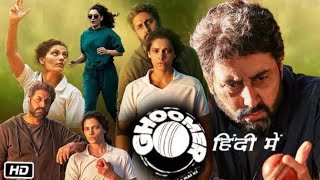Language: Hindi
Genre: Sports Drama / Emotional Comeback Story
Director: R. Balki
Lead Cast: Saiyami Kher, Abhishek Bachchan
Runtime: Approx. 2 hours 15 minutes

1. Core Story (No Spoilers)
Ghoomer tells the deeply moving story of Anina Dixit, a young and exceptionally talented female cricketer who dreams of representing India. Her dream is cruelly derailed when she loses her right hand in a tragic accident just before a major selection. What follows is not just a sports comeback story, but a layered journey of physical, emotional, and psychological resurrection.
Enter Paddy (Padam Singh Sodhi), a former cricketer turned alcoholic, bitter and washed-up due to his own unfulfilled past. He discovers Anina, battered but unbroken, and decides to train her in an unorthodox, intense, often brutal way—preparing her not just to return, but to do the impossible: play international cricket as a bowler with one hand.
2. Thematic Layers
A. Resilience in the Face of Loss
At its heart, Ghoomer is about how human beings react when their very identity is ripped from them. Anina loses not just a limb, but the thing she loved most—her game, her purpose. Her journey is about redefining self-worth beyond pity or limitation.
B. Mentorship, Not Just Coaching
Paddy is more than a coach. He’s a deeply flawed human, carrying guilt, regret, and bitterness. His bond with Anina is raw, uncomfortable, and deeply human. He doesn’t coddle her. He breaks her—mentally and physically—so that she can rebuild herself stronger than she ever imagined.
C. What Makes a Champion
The film poses powerful questions: Is a champion someone who wins trophies, or someone who refuses to surrender? Is technique more important than spirit? Is sympathy the enemy of real achievement?
D. Disability vs. Ability
Ghoomer never portrays Anina as a victim. Her disability is real, but it’s never the point. The film focuses on ability through adversity. Her one-handed bowling is not a gimmick—it’s a reinvention of the sport through necessity, determination, and tactical genius.
3. Characters in Depth
Anina Dixit (Saiyami Kher)
Anina is ambitious, fierce, and focused—but also vulnerable. After her accident, we see her at her weakest: angry, broken, and directionless. Her transformation is not miraculous. It’s slow, painful, and filled with emotional breakdowns. But it’s in this honest struggle that she becomes truly heroic. Her character becomes a symbol—not of “inspiration porn,” but of real, earned triumph.
Padam Singh Sodhi aka Paddy (Abhishek Bachchan)
Paddy is one of the most layered mentor figures in Indian cinema. He’s gruff, crude, and almost cruel at times. His coaching methods are bizarre—more psychological than technical. But beneath the bitterness is a man who knows loss, who sees a second chance in Anina’s pain. His arc is also redemptive: helping her rise gives him a reason to live again.
Supporting Characters
- Anina’s Grandmother is wise, tender, and quietly powerful—a contrast to the hyper-masculine coaching environment.
- Teammates and selectors offer a spectrum of responses—from support to skepticism—reflecting how society views disability and merit.
- Love interest (if any) is kept subtle, secondary to Anina’s inner world. The film wisely avoids making romance her savior.
4. Artistic Choices
A. Direction
R. Balki directs with a clear vision: to tell a personal story with national resonance. He doesn’t make the film loud or melodramatic. Instead, he allows the camera to stay focused on faces, silences, training sequences, and emotional nuance. The film doesn’t rush toward triumph—it walks with limping legs toward it, making the climax even more powerful.
B. Visual Storytelling
Training montages are not just physical—they’re deeply symbolic. The repetition of movement, the focus on balance, the strategic use of the left hand, the framing of pain—these all show the inner journey as much as the outer one.
The cricket scenes are shot with intensity and realism. There’s no over-stylized, Bollywood-ish action. Each delivery from Anina feels earned, grounded in sweat and technique.
C. Sound and Music
The background score is emotionally rich but restrained. It supports the story without manipulating the audience. In moments of silence—when Anina stares at her bandaged hand, or when she’s humiliated on the field—the quiet is deafening. Music swells only when the story demands release.
5. Symbolism & Metaphor
- Ghoomer (the dance) – The title refers to the traditional Rajasthani folk dance that involves spinning in circular motion. This becomes a metaphor for Anina’s bowling action and her life. Just like in the dance, control in chaos becomes her strength.
- Spinning Ball – Symbolizes not just the sport but the constant movement of fate. What looks like a downfall (a spinning fall) becomes her greatest weapon—a spinning comeback.
- One Hand – More than a disability, it becomes a visual metaphor for singular focus, minimalism, and transformation under pressure.
- Cricket Field – A battlefield, a proving ground, and ultimately a space of rebirth.
6. Emotional Journey
The film deliberately breaks the viewer down along with Anina. Watching her lose her dream and slowly crawl back to it—defying doctors, selectors, self-doubt, and society—is emotionally draining and inspiring. The audience goes from sympathy, to admiration, to sheer awe.
It’s not just about victory in the final match. It’s about every tiny step she takes on the way—every drop of sweat, every insult, every doubt she conquers.
7. Final Message
Ghoomer is not just a film about cricket. It’s about what it takes to matter—in a world quick to discard damaged goods. It reminds us that heroes are not those who are flawless, but those who refuse to stay broken.
In Conclusion
Ghoomer is a powerful sports drama wrapped around a very human story of loss and recovery. With subtle direction, layered performances, and a unique take on disability and mentorship, it elevates itself beyond formulaic underdog tales.
It’s a film that leaves you not just cheering, but thinking—about your own limitations, about the strength of the human spirit, and about how sometimes, the most graceful things in life emerge from imbalance.
